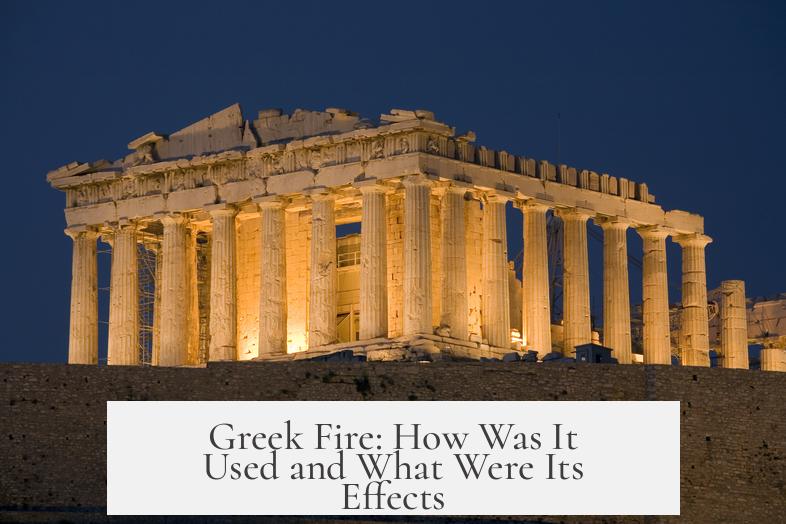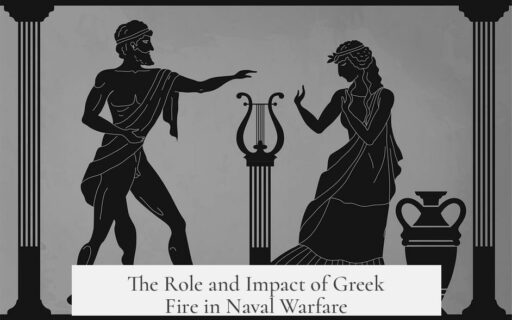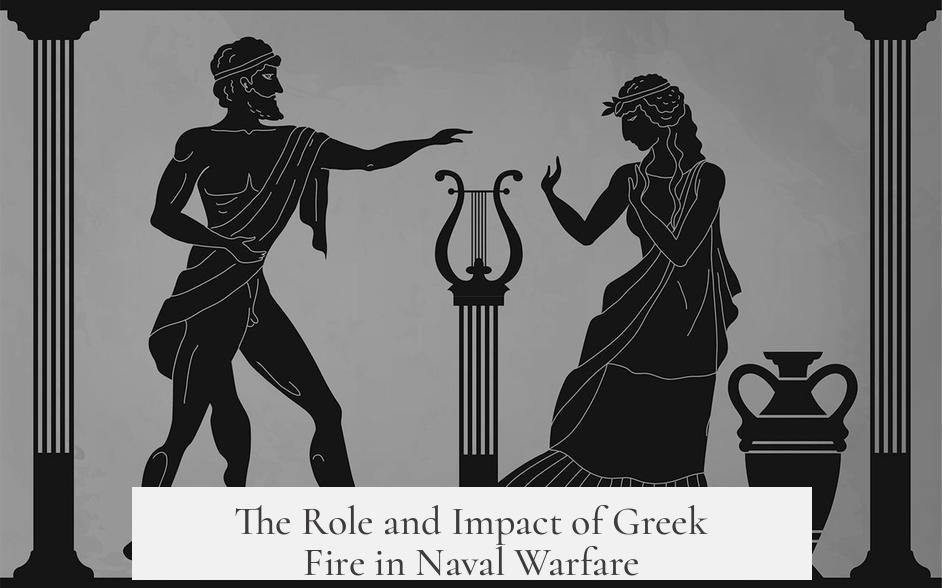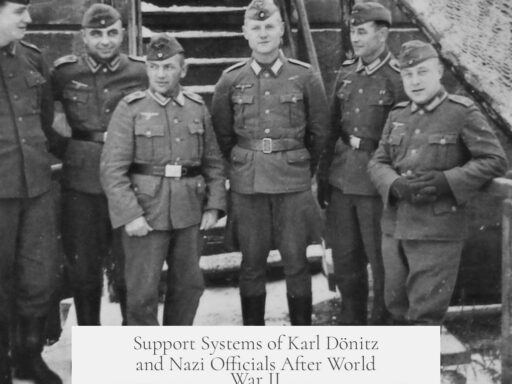Greek Fire was a formidable incendiary weapon used primarily by the Byzantine Empire, deployed mainly on ships. It played a crucial role in naval and siege warfare by projecting a burning liquid that was difficult to extinguish, changing the dynamics of battle and leaving both physical and psychological effects on its enemies.
The main deployment method of Greek Fire at sea was through a specialized device known as a siphon. This apparatus was typically mounted on the prows of Byzantine warships, but later configurations placed siphons on the sides and rear as well. These siphons were made from bronze or brass and had nozzles often decorated with dragon-shaped faces to intimidate foes. Operators, called siphonotors, controlled these devices from fortified platforms equipped with iron or brass shields for protection.
The mechanism included complex systems of levers and gears, allowing the operator to direct the fiery stream up to a 60-degree arc either vertically or horizontally. The Greek Fire mixture was stored in large bronze vats kept warm to maintain flow properties. To launch the fire, several men pumped the mixture through leather tubes using force pumps, forcing the liquid out at high pressure—possibly reaching distances up to 100 feet. The volatile substance ignited at the nozzle tip by a fixed wick or torch, spraying a continuous jet of fire towards enemy ships or fortifications.
Though powerful, the weapon had notable tactical limitations. It required calm seas and stable conditions to operate effectively, meaning it was less useful during rough weather or in highly mobile engagements. Despite this, when conditions were favorable, Greek Fire was devastating. It played a major role in defending Constantinople during critical moments in the 7th and 8th centuries. During the Arab sieges of AD 674-678 and AD 717, Greek Fire helped the Byzantines repel large-scale attacks. Modern historians recognize these events as pivotal examples of Greek Fire’s impact.
| Battle | Date | Role of Greek Fire |
|---|---|---|
| Arab Siege of Constantinople | 674-678 AD | Essential in defending the city, disrupting Arab fleets |
| Arab Siege of Constantinople | 717 AD | Key factor in Byzantine victory, inflicting severe naval losses |
| Siege of Constantinople by Kievan Rus’ | 941 AD | Used on 12 refurbished ships to decisively defeat a larger fleet |
One of the greatest demonstrations of Greek Fire’s effectiveness took place during the 941 AD siege by the Kievan Rus’. The Byzantines had only a dozen old ships to confront a massive invasion force. By outfitting these limited vessels with Greek Fire siphons, they turned the tide. The flaming liquid caused panic and heavy casualties. Many Rus’ attackers leapt into the sea to escape the fire but drowned under their armor or were incinerated by the burning waves.
The psychological impact of Greek Fire was as powerful as its physical destruction. The device’s dragon-shaped nozzles and the terrifying sight of flames that burned on water unnerved enemies. Conventional firefighting methods failed against it. Its reputation inspired dread and hesitation, contributing to Byzantine intimidation strategies. The weapon fit neatly within Byzantine military doctrine, which valued psychological warfare alongside tactical dominance.
- Greek Fire was primarily deployed via siphons mounted on Byzantine warships.
- Operators used mechanical controls to aim a jet of burning liquid up to 100 feet.
- It required calm weather to be used effectively, limiting tactical use.
- It had a decisive role in defending Constantinople during several major sieges.
- The weapon caused massive physical destruction and induced deep fear among enemies.
- The sight and effects of Greek Fire enhanced Byzantine psychological warfare.
Greek Fire: How Was It Used and What Were Its Effects?

Greek Fire was a game-changer in Byzantine naval warfare, acting like a flamethrower on the high seas that struck fear into the hearts of enemies. This terrifying weapon was used primarily via a specialized device called a siphon. Imagine a dragon-headed nozzle spraying out liquid fire, capable of burning even on water. This setup was as much about spectacle and psychological warfare as sheer destructive power.
Now, the question arises: how exactly was Greek Fire used, and what impact did it have during battles? Let’s dive deeper into this fascinating topic.
Deployment on Ships: The Art and Science of Fiery Warfare
The Byzantines didn’t just toss a flaming bucket overboard. They engineered something far more sophisticated—a mechanical contraption known as the siphon. Mounted primarily on the prows of warships, these massive bronze or brass devices looked like dragon heads. These fierce visages were more than decoration—they symbolized the terrifying breath of destruction about to be unleashed on enemies.
A platform or tower, protected with strong iron or bronze shielding, housed the siphonotor—the specialist who operated the fiery nozzle. This operator controlled the spray with carefully designed mechanical controls. The siphon could aim the blazing liquid in a sweeping 60-degree arc both vertically and horizontally. Talk about precision targeting!
The fiery stream itself came from a force pump system, worked by two or three men. They pumped Greek Fire from a large bronze vat, where it was kept warm to stay fluid and sticky. Picture a team of sailors heaving on leather tubes, pushing a mixture of flammable goo through the nozzle. At the tip, a small torch ignited the fluid, creating a stream of fire that could reach up to 100 feet. The image is both fascinating and a little terrifying.
The Effects of Greek Fire on Naval Battles
However, this powerful weapon had limitations. It was most effective in calm seas and fair weather—stormy waters and rough waves made operation tricky or impossible. Even so, when conditions allowed, Greek Fire was devastating.
Consider the historical stage where Greek Fire truly shined. During the Arab Sieges of Constantinople (AD 674-678 and again AD 717), this weapon helped the Byzantines hold the city against their fiercest attackers. Without Greek Fire, these sieges might have ended in disaster.
Fast forward to the Siege of Constantinople in 941 AD, when the Kievan Rus’ launched an invasion fleet. The Byzantines scrambled to gather just 12 old ships, hardly a fleet to write home about. They equipped these vessels with Greek Fire siphons and turned the tide spectacularly.
“Placed in the midst of the Russians, [the Byzantine crews] cast their fire all around. The Russians, terrified, jumped into the sea rather than face the flames. Many drowned under the weight of their armor; others were incinerated in the burning waves. None survived unless they swam to shore.” — A vivid account from the battle
The physical damage Greek Fire caused was matched by its psychological impact. Imagine facing an enemy that douses your ships with a liquid that burns uncontrollably on water. The dark bronze dragon heads spraying fire created a terrifying spectacle. Commanders knew this weapon sowed dread, lowering morale and often breaking enemy formations before engagement.
Why Did Greek Fire Matter Beyond the Flames?
The Byzantine military strategy hinged on intimidation and skill. Greek Fire exemplified this perfectly. It wasn’t just a weapon; it was a symbol of the empire’s ingenuity and willpower. Enemies didn’t just fear the destruction of their ships—they feared the unknown horror engulfing them in flames that water couldn’t quench.
This psychological edge is as potent as any physical weapon. Battles are won not only by brute strength but also by striking fear in foes. Greek Fire gave the Byzantines a reputation that often preceded them, tilting odds in their favor.
Lessons and Reflections on Greek Fire’s Legacy
Today, Greek Fire fascinates historians and science buffs alike. Its exact composition remains a mystery, a secret lost in time, much like the fire itself. Trying to replicate it has proven difficult. Yet its story teaches us about innovation in warfare—how technology and psychology can blend to create powerful tactical advantages.
Here are some practical takeaways from the Greek Fire saga:
- Innovate boldly: The Byzantines didn’t settle with traditional weapons. They crafted something unique and deadly.
- Leverage design: The dragon imagery was not just for show. It amplified fear, giving psychological weight to the physical threat.
- Know your environment: Greek Fire’s effectiveness depended on conditions. Understanding limitations is as vital as pushing capabilities.
- Psychological warfare counts: Destabilizing your opponent’s mind is often half the battle.
What if modern warfare still had such a mythical weapon? Would ancient Greek Fire still dominate the seas today, or has technology left it in the ashes? It’s fascinating to ponder how one empire’s fiery innovation shaped history.
In sum, Greek Fire was a brilliant fusion of art, science, and fear. It turned ships into dragons breathing literal fire, reshaping naval combat forever. Its effects went far beyond burning enemy vessels; it burned a lasting image into history. The Byzantines’ secret weapon remains an enduring symbol of strategic ingenuity.




